
Here are the top Workplace collaboration and teamwork statistics to help you in 2024 and beyond;
Building a Dream Team: The Power of Collaboration And Teamwork
It’s no secret that organizations thrive on teamwork. A strong, ambitious team fueled by open communication, shared goals, and clear roles is a recipe for success. But here’s the surprising catch: many managers aren’t confident their employees grasp the company’s direction.
The solution? Fostering a collaborative environment where everyone works together seamlessly towards shared objectives. This article dives deep into the power of teamwork, equipping you with insightful statistics and the latest trends in team building and collaboration. By the end, you’ll have the tools to create a truly efficient workforce and propel your business forward.
Teamwork vs. Collaboration: Unveiling the Nuances

At first glance, teamwork and collaboration might seem like synonyms. After all, both involve people working together towards a common goal. However, employers often differentiate between these terms, and for good reason. Here’s how they differ:
- Teamwork: A Building Block: Teamwork is the foundation. It involves individuals contributing their assigned tasks to achieve a shared objective. Think of it like constructing a building – each team member lays a specific brick.
- Collaboration: A Symphony of Ideas: Collaboration takes teamwork a step further. It’s a more fluid process where people work as equals, often without a designated leader. They share ideas, brainstorm solutions, and make collective decisions. Imagine an orchestra – each musician plays a part, but they listen and adapt to each other to create a harmonious piece.
The Power of Collaborative Teamwork (workplace collaboration and teamwork statistics)
While both teamwork and collaboration are valuable, the magic truly happens when they’re combined. This sweet spot, known as collaborative teamwork, leverages the best of both worlds:
The Power of Collaboration And Teamwork: Statistics That Speak Volumes
Building a successful organization hinges on a strong foundation – teamwork and collaboration. Here are some compelling statistics that highlight their undeniable impact:
- The Cornerstone of Success: A resounding 75% of employers agree that teamwork and collaboration are essential ingredients for a thriving workplace (source).
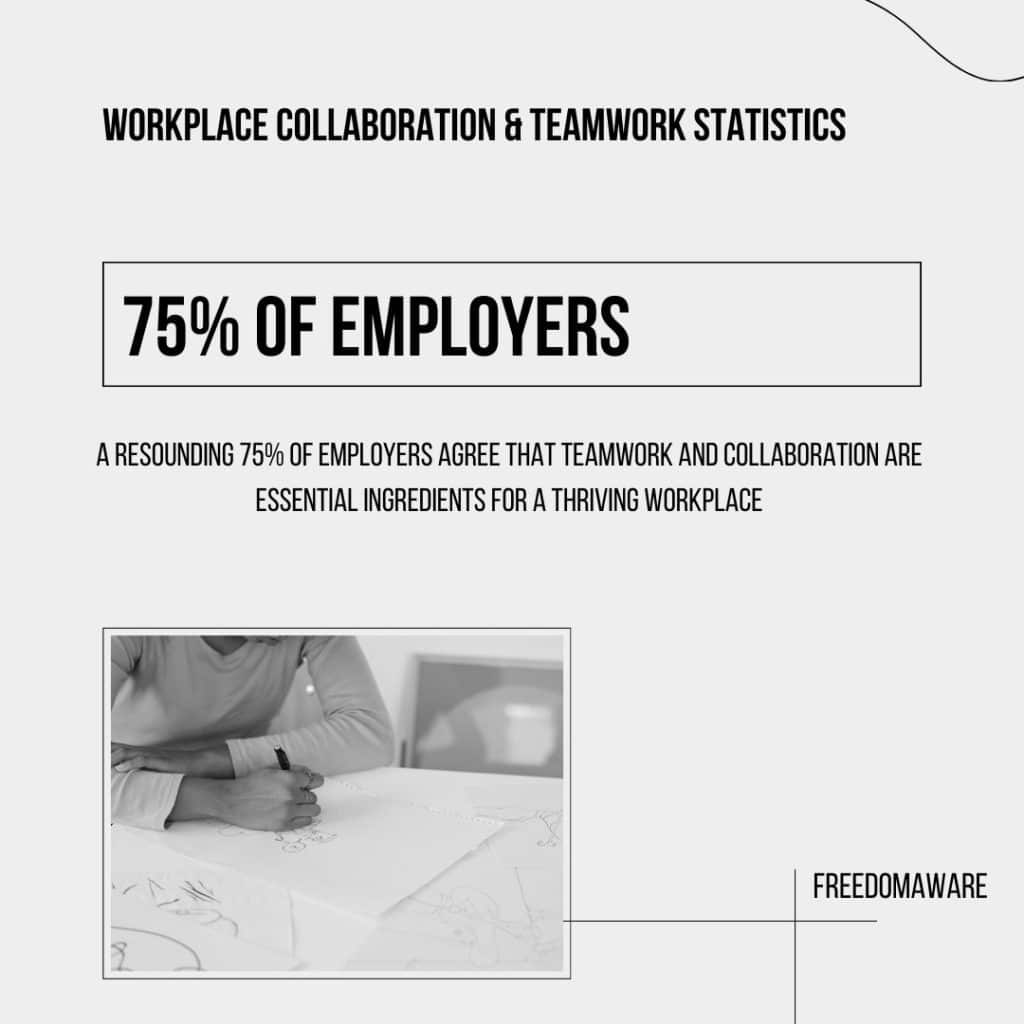
- The Cost of Disunity: Collaboration breakdowns are a major pain point, with 86% of business leaders citing them as a root cause of workplace failures (source).
- The Ripple Effect: Effective communication and collaboration have a far-reaching impact on businesses. Strong teamwork fosters trust, employee retention, engagement, and, ultimately, productivity (source).
- The Power of “We” Over “Me”: Companies that embrace teamwork and collaboration outperform their less collaborative counterparts by a staggering 5 times (source). This is a clear testament to the power of a unified team.
- A Growing Market: The demand for collaboration is evident in the software market. Revenue for collaboration software is predicted to rise continuously by 10.4% between 2023 and 2028 (source).
- The Human Touch Endures: Even in an increasingly remote work landscape, a surprising statistic emerges: most U.S. workers emphasize the importance of in-person collaboration for their jobs (source). This highlights the value of fostering opportunities for face-to-face interaction alongside remote collaboration tools.
- Shared Ownership: With solid leadership, collaborative teamwork ensures everyone feels invested in the goal. Tasks are distributed fairly, often based on individual strengths. (source)
- Efficiency Through Synergy: Collaborative teamwork allows for efficient work. By sharing ideas and expertise, the team can find the best solutions faster. (source)
- Motivation Boost: Working together can be energizing! Collaborative teamwork fosters a sense of community and shared purpose, leading to a more motivated workforce. (source)
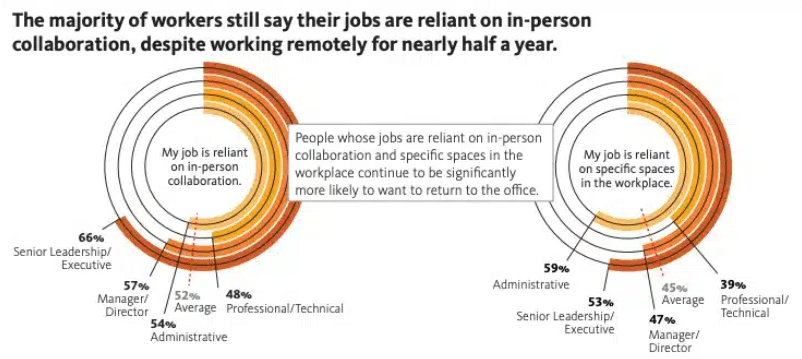
- The In-Office Advantage: While remote work has become a prominent trend, there’s a clear preference for in-office collaboration. Nearly half (49%) of surveyed U.S. workers find collaborating in the office easier compared to just 15% who prefer doing so at home (source). This suggests the value of physical proximity for some aspects of teamwork.
- The Power of Shared Knowledge: Collaboration isn’t just about brainstorming – it fuels performance! A significant 30% of employee performance improvements are attributed simply to information sharing among colleagues (source). This highlights the importance of fostering open communication within teams.
- The Collaboration Boost: Teamwork isn’t just about feeling good – it’s good for business! Studies suggest that teamwork and collaboration in the workplace can lead to a substantial sales increase of 27% (source). This is a compelling argument for investing in collaborative practices within your organization.
Collaboration And Teamwork: The Cornerstone of Success in Today’s Workplace
The statistics paint a clear picture: collaboration is no longer a nice to have. It’s a game-changer. Here’s how collaboration is impacting businesses today:
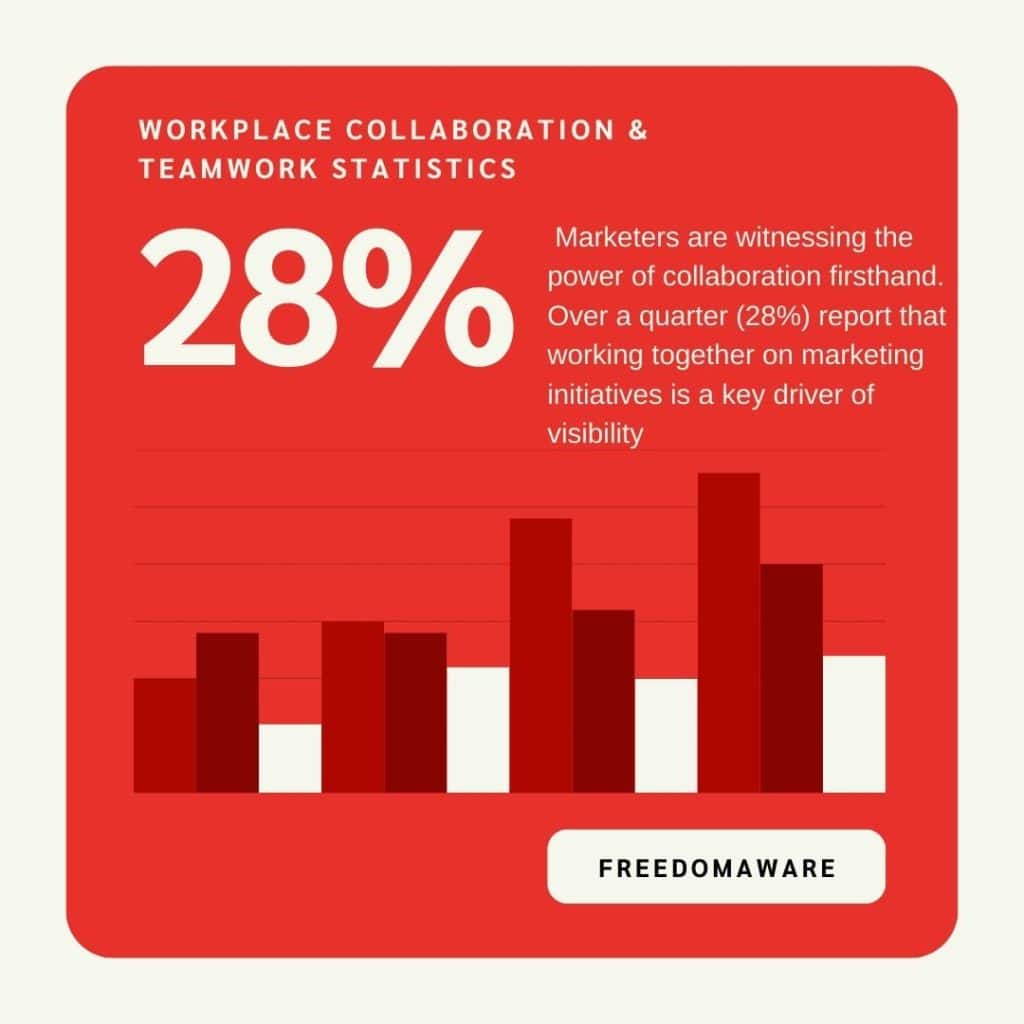
- Marketing Magic: Marketers are witnessing the power of collaboration firsthand. Over a quarter (28%) report that working together on marketing initiatives is a key driver of visibility (source).
- A Must-Have Skill: Collaboration isn’t just for marketing teams. According to Forbes, it’s one of the top 5 skills every worker needs to succeed (source).
- A Booming Market: The demand for collaboration tools is surging! The global market for enterprise collaboration is expected to balloon to $90.60 billion by 2028, driven by the rise of online and mobile collaboration solutions (source).
- Tech to the Rescue: A whopping 83% of employers leverage technology to foster collaboration (source). This includes tools like video conferencing, project management apps, and instant messaging platforms.
- The Future is AI-Powered: Collaboration is evolving! Over 1,500 companies are already integrating human intelligence with AI for collaborative projects (source).
- In fact, 94% of companies are actively exploring solutions that combine human intelligence and AI to enhance collaboration (source).
- The Employee Desire: Employees crave a collaborative environment. A staggering 91.1% express a desire to work in organizations that prioritize open communication and collaboration (source).
- The Cost of Disunity: Both employees (97%) and employers (97%) agree a lack of teamwork hinders overall results (source).
The message is clear: fostering collaboration through communication, technology, and open-mindedness is the key to building a successful and thriving organization.
Teamwork: Supercharging Employee Wellbeing and Business Success (workplace collaboration and teamwork statistics)
Effective teamwork isn’t just about achieving goals – it fosters a thriving work environment. Here’s how collaboration benefits both employees and businesses:
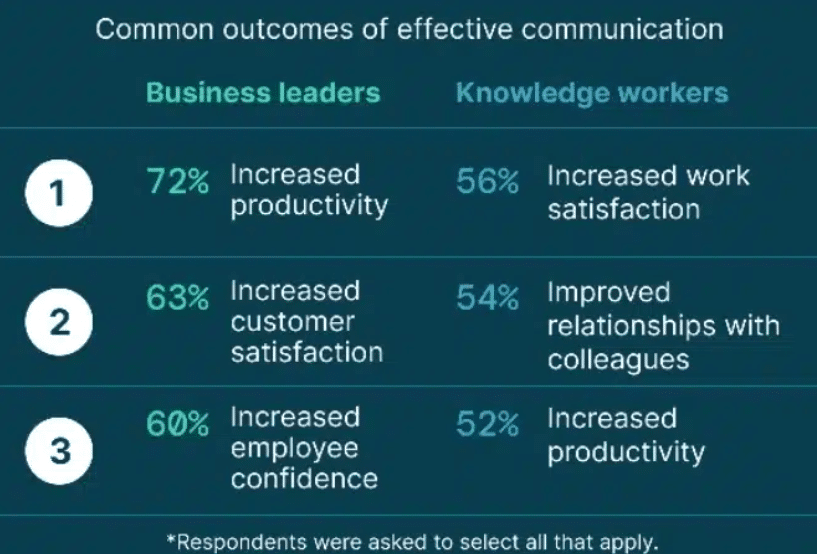
- Employee Wellbeing: Teamwork is a well-being booster! It provides essential emotional support, helping to reduce burnout for a significant 60% of workers. (source)
- Self-Awareness & Engagement: Collaboration enhances self-discovery. 41% of employees report that teamwork helps them identify their strengths and weaknesses, leading to increased engagement and reduced absenteeism. (source)
- Productivity Boost: Collaboration platforms aren’t just a fad – they’re productivity powerhouses! Forrester’s research suggests that effective team collaboration platforms can improve productivity by a remarkable 10%. This translates to employees saving 5-10% of their work time, leading to reduced stress. (source)
- Retention Rocket Fuel: Happy employees stay longer! Effective communication and collaboration can generate a staggering 4.5 times higher talent retention rate. (source)
- Happiness & Productivity Hand in Hand: Happiness is contagious, and it’s good for business! A report reveals that a positive work environment fosters a 13% increase in employee productivity. Teamwork helps create a friendlier and less stressful atmosphere, leading to happier and more productive employees. (source)
- The Collaboration Advantage: The numbers speak for themselves! Employees who experience effective communication and collaboration report a 72% increase in productivity, a 63% improvement in customer service, and a well-deserved 60% boost in confidence. (source)
- The Open Collaboration Effect: Openness breeds productivity! When teamwork and collaboration create an open environment, it leads to a significant 17% increase in worker productivity. (source)
- The Happiness Advantage: Happy employees are high performers! Studies show that happy employees outperform their unhappy counterparts by a remarkable 20%. This reinforces the importance of fostering a positive and collaborative work environment. (source)
- The Stress Factor: Workload isn’t the only culprit behind employee stress. While heavy workloads contribute to over 36% of stress, team dynamics play a surprisingly large role, impacting a whopping 92% of stress factors related to employees. This highlights the importance of fostering healthy team dynamics to create a more positive work environment. (source)
- The Remote Collaboration Challenge: Collaboration isn’t always seamless, especially for remote teams. A significant 16% of remote workers identify difficulties in collaboration and communication as a major hurdle. This underlines the need for effective communication strategies and collaboration tools to bridge the gap for geographically dispersed teams. (source)
Challenges on the Path to Collaboration (workplace collaboration and teamwork statistics)
While collaboration offers numerous benefits, it’s not without its hurdles. Here are some common roadblocks to address:
- Communication Breakdowns: Miscommunication is a deadline killer! Nearly a third (28%) of employees report that miscommunication is a primary culprit behind missed deadlines. (source)
- Alignment Blues: A team on the same page is a productive team. A staggering 97% of business leaders and employees agree that a lack of alignment within a team significantly impacts project outcomes. (source)
- The Shadow of Skill Overlap: Collaboration isn’t always sunshine and rainbows. Skill overlap within teams can sometimes lead to issues, along with reduced engagement and unhealthy internal competition. Careful team composition and management are crucial to mitigate these challenges. (source)
- Silo Mentality: Breaking down departmental barriers is key to success. A significant 41% of respondents find collaborating across departments more challenging than working within their own departments. (source)
- This is further emphasized by the statistic that 75% of business executives admit their departments compete rather than collaborate on digital projects. These findings highlight the need to foster a culture of cross-functional collaboration throughout the organization. (source)
- Feeling Isolated, Not Inspired: Employees who feel isolated are less productive! Studies show that feelings of employee isolation can lead to a significant 21% decrease in productivity. (source)
- Goal Setting Gaps: Unclear goals can lead to confusion and hinder teamwork. Nearly 36% of surveyed U.S. employees admit they don’t personally track their team’s goals. (source)
- Over half (53%) reported having limited to no visibility into other teams’ goals. This underscores the importance of setting clear, transparent goals that everyone understands. (source)
Bridging the Distance: The Rise of Online Collaboration Tools (workplace collaboration and teamwork statistics)
Technology is transforming the way we work together, especially for remote teams. Here’s how online collaboration tools are making a difference:
- Video Conferencing Takes Center Stage: A whopping 76% of the global workforce leverages video conferencing as a vital remote work tool. (source)
- Younger Generations Embrace Tech: There’s a clear generational preference for online collaboration tools. A significant 86% of younger employees (25-34) prefer video conferencing for online teamwork compared to just 46% of older employees (55+). This highlights the need for a variety of communication methods to cater to different preferences. (source)
- Tech-Savvy Collaboration: Young employees are leading the way in embracing technology for collaboration. Around 60% of younger employees effectively utilize at least three online tools to collaborate with colleagues. (source)
- The Collaboration Boom: The use of collaboration tools is skyrocketing! There’s been a remarkable 44% increase in these tools for work purposes between 2019 and 2021. This surge reflects the growing acceptance and importance of online collaboration in today’s work environment. (source)
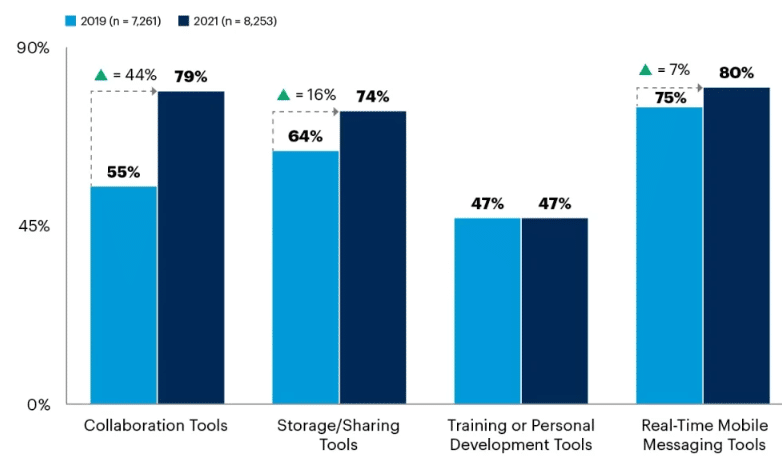
The Evolution of Collaboration And Teamwork: Pre-Pandemic, Pandemic, and Beyond
The way we collaborate has undergone a transformation:
- Pre-Pandemic Collaboration Landscape: Before COVID-19, in-person and online collaboration played a significant role in the workday. U.S. workers dedicated about 43% of their time to collaborative efforts. (source)
- The Pandemic Shift: The pandemic impacted collaboration patterns. With a shift to remote work, the percentage of time spent collaborating dropped to 27%. This highlights the need for effective strategies to foster collaboration in remote environments. (source)
- A Booming Collaboration Software Market: The demand for collaboration tools is surging! The global collaboration software market is projected to reach a staggering $17.9 billion by 2025. (source)
- with the team collaboration software market expected to reach $24.2 billion by 2027. (source)
- The Rise of Remote Collaboration Tools: Specific tools gained popularity during the shift to remote work. In 2020, Zoom emerged as a top choice in the U.S., with over 36% of workers using it for video conferencing. (source)
- The Collaboration App Surge: The need for remote collaboration solutions accelerated rapidly. In May 2020, there was a massive 176% increase in the installation of enterprise collaboration apps, reflecting the growing number of remote jobs. (source)
- Communication Champions: Communication is a cornerstone of collaboration. Two popular platforms, Slack and Microsoft Teams, exemplify this trend. A Slack report revealed that over 600,000 companies used Slack for team messaging in 2019. (source)
- while a VentureBeat report indicated that over 500,000 companies utilized Microsoft Teams as a collaboration tool in the same year. (source)
Building Strong Teams Virtually: A Growing Trend (workplace collaboration and teamwork statistics)
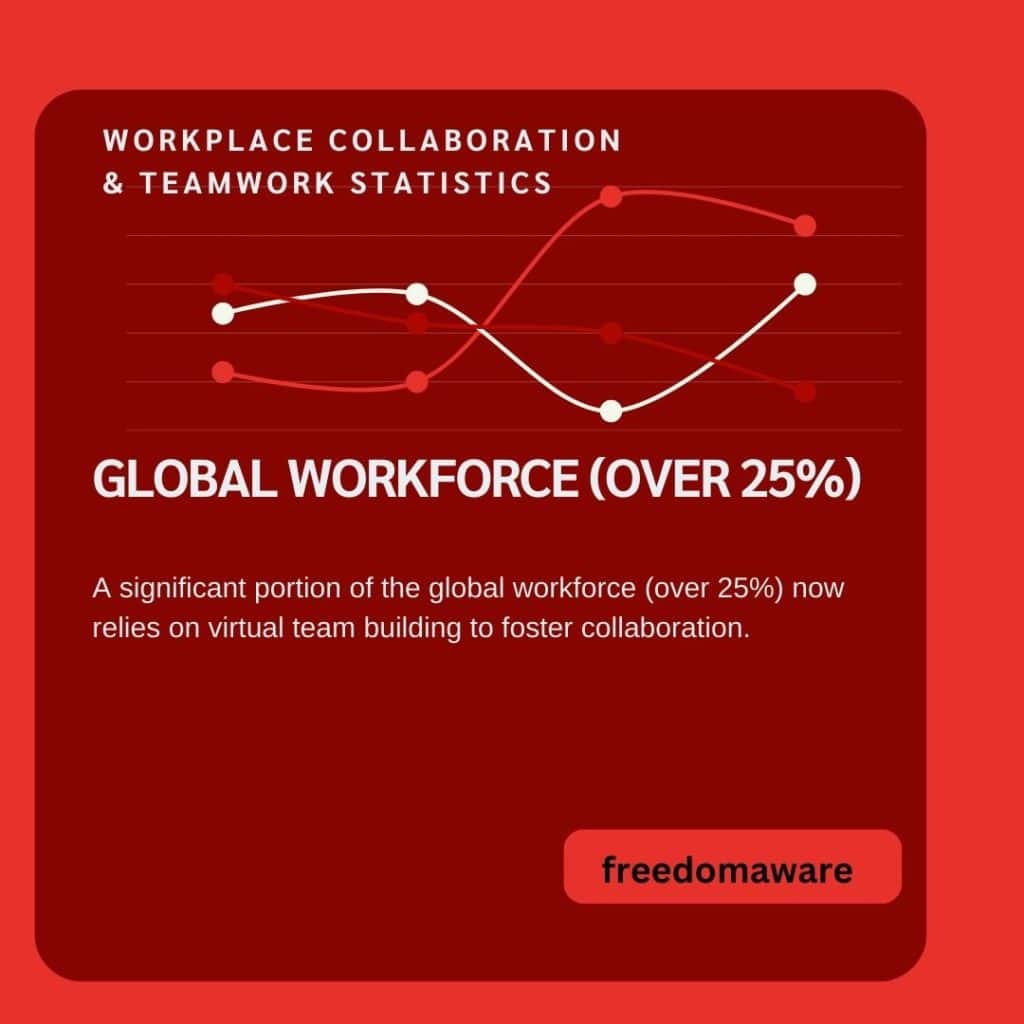
Team building isn’t just for in-person offices anymore! Here’s how virtual team building is taking center stage:
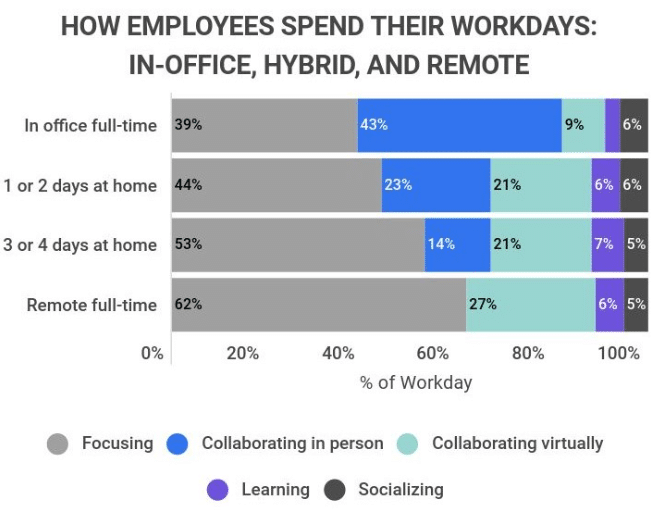
- The Rise of Virtual Teams: A significant portion of the global workforce (over 25%) now relies on virtual team building to foster collaboration. (source)
- The Future of Work: Virtual & Permanent: Virtual team setups are here to stay! A strong 64% of surveyed companies believe virtual teams will become a permanent fixture in business operations. (source)
- Leaders Invest in Team Culture: Business leaders recognize the value of team building. Over half (55%) believe investing in team-building activities will lead to a more positive and productive team culture. (source)
- Virtual Success Stories: The numbers speak for themselves! 75% of surveyed workers report experiencing improved performance remotely due to virtual team-building initiatives. (source)
- Global Leaders in Virtual Team Building: Singapore takes the top spot when it comes to investment in virtual team building, with the U.S. following closely behind. This reflects the growing importance of building strong virtual teams in today’s globalized workplace. (source)
- An Employee Desire: More Team Building: Employees crave a focus on team building! A resounding 73% of workers express a desire for their organizations to invest more in effective team-building activities. (source)
- Emphasizing the Widespread Need: Teamwork makes the dream work! A significant portion of the U.S. workforce – more than 50% – indicates that collaboration is essential to their daily tasks. (source)
- Highlighting the Value: Strong teamwork is a top priority! A whopping 75% of employees rate collaboration and teamwork as essential for success in their roles. (source)
- Modernizing Communication Channels: Reaching employees where they are! A significant 56% of employers are embracing online collaboration tools and social media as communication channels to engage with their employees. (source)
- Leaders See the Collaboration Gap: Breakdown in Teamwork = Breakdown in Success! Leaders on the front lines know it best – 86% of them identify a lack of collaboration as the primary reason for projects and initiatives falling short. (source)
- The Collaboration Retention Connection: Keeping your best talent? Companies that prioritize collaboration and communication have been linked to a significant drop (50%) in employee turnover. (source)
- The Collaboration-Happiness Connection: Feeling good at work? Teamwork might be why! Studies show that employees who collaborate with colleagues experience a jump of 17% in job satisfaction on average. (source)
- The Collaboration Revolution: Working together is the new normal! Over the past 20 years, there’s been a dramatic shift towards collaboration in the workplace, with a minimum increase of 50%. (source)
- The Collaboration Advantage: Tech-powered teamwork unlocks a happier workplace! When employees have the opportunity to collaborate effectively with the help of digital tools, their satisfaction with their jobs and the overall work environment jumps by up to 17%. (source)
- A Recipe for Peak Performance: Top performers excel by strategically dividing their time. 45% goes to focused individual work, 45% to collaborative teamwork, and the remaining 10% is invested in learning and social interaction – all crucial components of workplace success. (source)
- The Power of “We” Over “Me”: Collaboration unlocks success! Studies show that individuals working collaboratively achieve tasks more than 50% faster than their independent counterparts. (source)
- Employees Value Collaboration: Teamwork tops the charts! Most (52%) of U.S. employees rank teamwork as highly important in their work environment. (source)
- A Collaboration Disconnect: Many employees (39%) feel their colleagues don’t collaborate enough, highlighting a potential gap between perceived and desired collaboration levels. (source)
- Communication Room for Improvement: Only 27% of respondents felt confident in their communication skills, suggesting a need for communication training or initiatives to bridge this gap and foster more effective collaboration. (source)
- Emphasizing the Strong Preference: People Crave Collaboration! An impressive three-quarters (75%) of people view collaboration in the workplace as highly important. (source)
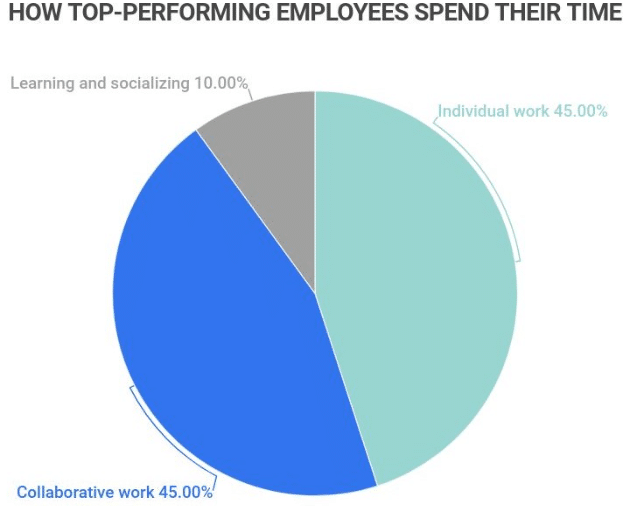
The Hidden Dollars in Teamwork (workplace collaboration and teamwork statistics):
Studies reveal the financial benefits of fostering a collaborative work environment:
- Idea Sharing & Task Collaboration Boost: Simply by collaborating on tasks and sharing ideas, organizations unlock an estimated $1,660 in value per employee annually. (source)
- Quality Improvement Through Teamwork: Collaboration doesn’t just boost efficiency; it elevates quality! Effective teamwork is associated with an impressive $2,517 improvement in quality per employee each year.
These numbers highlight the significant return on investment that collaboration brings to businesses. (source)
Unlocking Success Through Collaboration:
A Frost & Sullivan study revealed a powerful connection between collaboration and business success. Here’s how teamwork pays off:
- Sales Surge: Companies with strong collaboration see a remarkable 27% increase in sales, highlighting the power of teamwork in driving revenue growth. (source)
- Happier Customers, Higher Ratings: Collaboration fosters a customer-centric approach, leading to a 41% improvement in customer satisfaction ratings. (source)
- Enhanced Product Quality: When teams work together effectively, the quality of products improves by a significant 34%, ensuring customer satisfaction and brand reputation. (source)
- Faster Product Development: Collaboration streamlines processes, resulting in a 30% improvement in product development speed, allowing companies to stay ahead of the curve. (source)
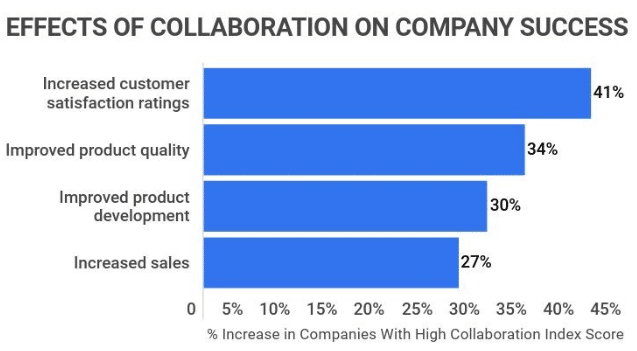
These statistics paint a clear picture: collaboration isn’t just a feel-good notion; it’s a strategic driver of business success.
- Collaboration Signals Employer Investment: Working together shows you matter! Companies that prioritize collaboration are 22% more likely to have employees who feel their well-being is valued. Collaboration suggests an investment in fostering a positive work environment. (source)
- The Collaboration Multiplier Effect: Teamwork multiplies success! Organizations that prioritize collaboration experience a staggering fivefold increase in the likelihood of achieving high-performance status. (source)
The Stress Factor: How Collaboration Can Be the Cure (workplace collaboration and teamwork statistics)
- Feeling overwhelmed at work? You’re not alone. A whopping 80% of employees experience stress on the job. (source)
- Studies reveal a surprising culprit behind much of this stress: team dynamics. A staggering 92% of work-related stress is linked to how well teams function. (source)
- The solution? Meaningful communication and collaboration! Experts recommend fostering open communication and teamwork as a powerful way to improve team dynamics. This, in turn, can significantly lower stress levels and help employees avoid burnout. (source)
By prioritizing collaboration, companies can create a more positive and productive work environment for everyone.
Innovation Ignites, Productivity Soars: The Power of Collaboration And Teamwork
Frost & Sullivan’s research highlights the undeniable benefits of collaboration for businesses:
- Innovation Powerhouse: Companies that embrace collaboration unlock a 30% boost in innovation. Teamwork fosters a dynamic environment where ideas can flourish, and creativity thrives. (source)
- Productivity on Autopilot: Collaboration isn’t just about good ideas; it’s about getting things done! Organizations with strong collaboration see a remarkable, at least 36% increase in productivity. Effective teamwork streamlines processes avoid bottlenecks and keeps projects moving forward efficiently. (source)
The Impact of Remote Work on Collaboration And Teamwork:
The shift to remote work has impacted how teams collaborate. Here’s what a recent poll revealed:
- Reduced Collaboration Time: Employees working full-time from home dedicate nearly half (48%) less time to collaboration compared to working in an office setting. ( source)
- Shifting Work Environment: The poll attributes this drop in collaboration to the significant changes in the work environment brought about by the COVID-19 pandemic. (source)
Time Management for Remote Workers: A Breakdown (workplace collaboration and teamwork statistics)
Research sheds light on how online employees typically distribute their workday:
- Focus Time Reigns Supreme: A significant portion of the workday (62%) is dedicated to focused individual work, such as completing tasks or tackling specific projects. (source)
- Collaboration Takes Second Place: While essential, collaboration occupies a smaller portion of the online workday, clocking in at 27%. (source)
- Investing in Learning and Socialization: Online employees dedicate 6% of their time to learning new skills or expanding their knowledge, while 5% is spent on social interaction with colleagues. (source)
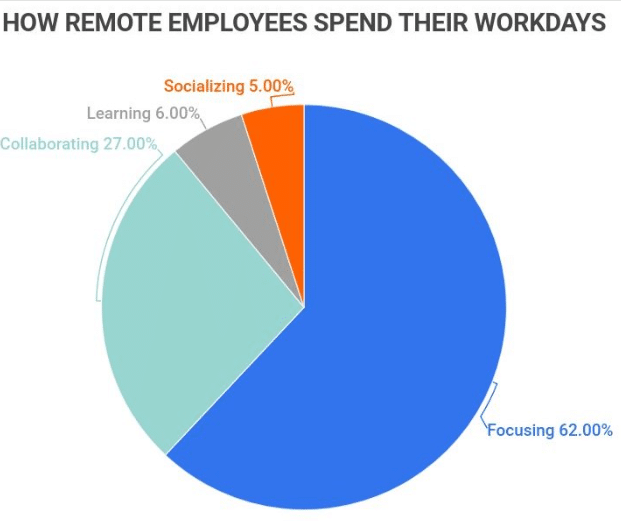
This breakdown highlights the importance of creating a structured workday for remote employees, ensuring they balance focused work with opportunities for collaboration, learning, and social connection.
Boosting Productivity Through Social Collaboration And Teamwork: A Generational Look
The rise of social networks has impacted how we work together. Here’s how employees view its influence on productivity:
- Overall Preference for Social Collaboration: Nearly half (45%) of the workforce believes that collaborating via social networks can enhance workplace productivity. (source)
Generational Breakdown: A closer look reveals interesting generational preferences:
- Tech-Savvy Millennials: The youngest generation surveyed, Millennials (born between 1981 and 1996), shows the strongest preference for social collaboration, with 50% reporting a belief in its productivity benefits. (source)
- Gen X Embraces Tech: Gen X (born between 1965 and 1980) follows closely behind, with 46% viewing social networks as a potential productivity booster. (source)
- Boomers Wary, But Open: Baby Boomers (born between 1946 and 1964) are the most cautious, with 40% acknowledging the potential benefits of social collaboration for productivity. (source)
These statistics suggest a growing acceptance of social networks as a valuable tool for workplace collaboration, with younger generations leading the way. As technology continues to evolve, social collaboration is likely to play an increasingly important role in boosting productivity across all generations.
Collaboration: A Blessing and a Curse in the Digital Age (workplace collaboration and teamwork statistics)
While collaboration is a proven productivity booster, online tools can introduce new challenges. Here’s what research reveals about distractions in the online workplace:
- Double-Edged Sword: Despite collaboration’s benefits, online tools can be a source of distraction. A significant portion of these distractions (41%) stem from personal conversations happening online during work hours. (source)
- Focus Disrupted: Incoming requests are another major distraction (39%), pulling employees away from their current tasks and projects. (source)
These findings highlight the need for a balanced approach. Organizations can leverage online collaboration tools for their many advantages while implementing strategies to minimize distractions and ensure employees can focus on their work. This might involve setting communication guidelines, establishing dedicated focus times, or utilizing features within the collaboration tools themselves to manage notifications and distractions.
The Collaboration And Teamwork Tech Landscape: A Multi-Platform World
With nearly 90% of businesses utilizing online collaboration tools for internal communication, a diverse range of platforms have emerged to meet their needs. Here’s a breakdown of some popular choices:
- Microsoft Takes the Lead: Microsoft Teams emerges as the frontrunner, with 31% of businesses preferring it for communication and collaboration. (source)
- Strong Showing for Skype: Microsoft Skype for Business remains a popular choice for 27% of businesses, showcasing its continued relevance. (source)
- Google Chat Gains Traction: Google Chat claims a significant share of the market, with 21% of businesses favoring its integration with other Google Workspace tools. (source)
- Cisco WebEx Teams and Zoom Round Out the Options: Cisco WebEx Teams (15%) and Zoom (13%) round out the top choices, offering businesses additional options to suit their specific needs. (source)

This variety reflects the evolving nature of workplace communication. Businesses can choose the platform that best aligns with their existing workflows, team size, and desired functionalities.
The Rise of Video Conferencing in 2019 (workplace collaboration and teamwork statistics):
A 2019 report by Life-size, the “2019 Impact Of Video Conferencing Report,” revealed a surge in video conferencing adoption at work:
- Video Calls on the Rise: Significantly more employees (48%) reported using video conferencing more frequently in 2019 compared to just two years prior. This highlights a growing preference for face-to-face interaction, even in a virtual setting. (source)
- Young Professionals Embrace Video: The study found that young professionals (aged 18-29) were leading the video conferencing charge, with a significant portion (25%) using it daily. This suggests a comfort level with technology and a desire for real-time collaboration. (source)
- Innovation Through Video: Interestingly, over half (51%) of survey respondents associated companies using video conferencing with being more innovative. This suggests a perception that video calls foster better communication and idea exchange, ultimately leading to a more innovative work environment. (source)
These statistics paint a clear picture: by 2019, video conferencing was rapidly becoming a preferred method of communication in the workplace, especially among younger generations. It was not only seen as a convenient tool but also linked to fostering a more innovative work culture.
Building Stronger Teams in 2024: Trends and Strategies for the Modern Workplace (workplace collaboration and teamwork statistics)
In today’s dynamic business landscape, effective teamwork is no longer a luxury – it’s a necessity. As we navigate a world shaped by remote work, hybrid teams, and an emphasis on innovation, the way we collaborate continues to evolve.
This guide explores the latest trends in teamwork, providing valuable insights and actionable strategies you can leverage to:
- Boost team morale and engagement in an era of dispersed workforces.
- Optimize communication and collaboration, fostering a culture of innovation and problem-solving.
- Develop strong team relationships that transcend physical distance.
By understanding these trends and implementing the right strategies, you can empower your teams to achieve peak performance and propel your business model forward in 2024 and beyond.
The Future of Teamwork (workplace collaboration and teamwork statistics): Embracing Collaboration in a Virtual World
The COVID-19 pandemic has fundamentally reshaped the way we work. Gone are the days of centralized offices and traditional team dynamics. Now, businesses are embracing a virtually connected work environment.
This shift has sparked a wave of innovation in team collaboration, with companies adapting their management styles and utilizing a robust suite of communication and collaboration tools. In this dynamic landscape, staying ahead of the curve is crucial.
This resource will delve into the latest team collaboration trends for the virtual workplace. We’ll explore how companies are:
- Leading virtual teams effectively in this new normal.
- Leveraging technology to bridge geographic distances and foster seamless collaboration.
- Building strong team connections despite physical separation.
By understanding these trends, you can equip your teams with the tools and strategies they need to thrive in the virtual workspace and unlock their full potential.
Collaboration And Teamwork Trends
1. Feedback (workplace collaboration and teamwork statistics): The Fuel for High-Performing Teams
Effective teamwork hinges on clear and consistent feedback. A recent survey of 1,000 U.S. employees underscores this notion: a staggering 74% of respondents identified frequent constructive feedback as a hallmark of high-performing teams.
This feedback loop empowers teams to continuously improve their strategies and execution. Recognizing this, organizations are placing a greater emphasis on providing constructive feedback that motivates and inspires employees, particularly those working remotely.
To facilitate this, companies are increasingly investing in sophisticated collaboration and communication tools that enable seamless feedback exchange, regardless of location. This investment not only strengthens team dynamics but also paves the way for sustained high performance.
2. Communication Tools (workplace collaboration and teamwork statistics): Building Bridges in the Virtual Workplace
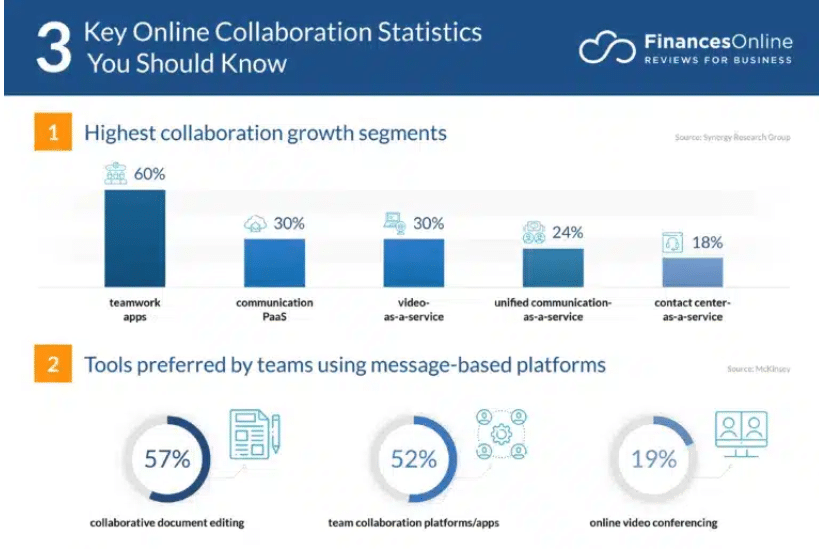
The rise of virtual teams, geographically dispersed and operating across time zones, has placed a premium on clear and efficient communication. As the demand for workplace flexibility continues to grow, companies are strategically shifting from on-premise collaboration tools to cloud-based solutions.
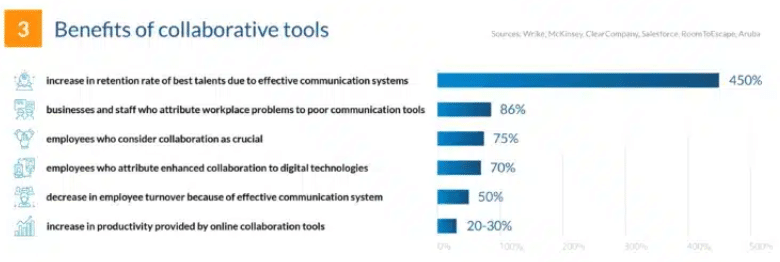
These cloud-based tools offer a multitude of benefits:
- Seamless Communication: They enable real-time communication across locations, ensuring everyone stays on the same page.
- Enhanced Collaboration: Team members can work together on projects, share files, and provide instant updates regardless of their physical location.
- Accessibility Across Devices: Accessibility on various devices (desktops, laptops, mobile phones) empowers everyone to stay connected and contribute, fostering a truly inclusive work environment.
The market offers a diverse range of tools to cater to specific needs, including:
- Video conferencing: Enables face-to-face interaction for building rapport and fostering teamwork.
- Conference chat services: Facilitate real-time conversations and quick updates.
- Commenting systems: Enable collaborative feedback and document editing.
Additionally, all-in-one solutions, such as email-based project management tools, streamline workflow by allowing teams to manage projects and communicate within a familiar platform, such as their email.
By investing in the right communication tools, companies can bridge geographical distances, create a more connected workforce, and unlock the full potential of their virtual teams.
3. The Metaverse (workplace collaboration and teamwork statistics): A Collaborative Frontier (Emerging Technology)
The emergence of the metaverse, a virtual world where users can interact and collaborate, presents exciting possibilities for the future of teamwork.
- Enhanced Collaboration: Companies are exploring the potential of creating virtual workspaces within the metaverse, allowing geographically dispersed teams to feel more connected and collaborate as if they were in the same physical location.
- Bridging the Distance Gap: By utilizing Augmented Reality (AR) and Virtual Reality (VR) technologies, teams can hold meetings and work together in virtual environments that mimic physical offices, fostering a sense of presence and shared experience.
- Idea Sharing & Innovation: These virtual spaces allow for dynamic idea-sharing and collaborative problem-solving, potentially sparking innovation and creativity within teams.
It’s important to acknowledge that the metaverse is still a developing technology, and its potential impact on teamwork is an ongoing discussion. While not all companies are currently implementing it, those pioneering this approach are exploring its capabilities to unlock new avenues for collaboration and build a more immersive and engaging work experience.
4. Asynchronous Collaboration (workplace collaboration and teamwork statistics): Embracing Flexible Work Schedules
The rise of remote and hybrid work models has fueled the popularity of asynchronous collaboration. This approach allows team members to contribute to projects on their own schedules without requiring real-time interaction.
- Flexibility for Remote Teams: Asynchronous collaboration empowers remote teams by granting them the flexibility to work when they are most productive, regardless of location or time zone.
- Employee Preference: A Buffer study revealed that a significant 52% of employees desire asynchronous work policies. This approach caters to individual work styles and preferences, potentially leading to increased employee satisfaction and engagement.
- Accessibility and Convenience: Asynchronous collaboration tools and platforms allow employees to access project materials and contribute their work at their convenience, fostering a more inclusive work environment.
By embracing asynchronous collaboration, companies can unlock the benefits of a flexible workforce. This will empower employees to contribute their best work while maintaining a healthy work-life balance.
Building Strong Teams in a Virtual World: Trends and Strategies for 2024 and Beyond
Team building has always been a cornerstone of effective collaboration. However, the rise of remote and hybrid work models necessitates a shift in our approach. This guide explores the latest trends in virtual team building, providing valuable insights and actionable strategies you can leverage to:
- Foster strong team connections despite physical separation.
- Boost team morale and engagement in a geographically dispersed workforce.
- Cultivate a sense of belonging and shared purpose within your virtual teams.
By embracing these trends and implementing the right strategies, you can ensure your virtual teams thrive in the new world of work.
The Remote Revolution: Why Virtual Team Building Matters More Than Ever
The surge in remote work arrangements is undeniable. As more companies adopt flexible work models, the ability to build and maintain strong teams across distances becomes paramount.
Statistics show that remote work is here to stay, making virtual team building a critical investment. This section will delve deeper into the reasons why virtual team building is essential for success in today’s workplace.
1. The Rise of Hybrid Teams (workplace collaboration and teamwork statistics): A New Era of Work
The concept of hybrid work, where employees split their time between working in an office and remotely, has gained significant traction in recent years. According to Murray Seward, CEO of Outback Team Building and Training, hybrid work models are poised to become increasingly dominant in the professional landscape.
This shift presents both opportunities and challenges for organizations:
- Adapting to Hybrid Work: Businesses must decide on the most suitable hybrid model for their needs, whether it’s a specific number of in-office days or a more flexible approach.
- Unlocking Potential: Hybrid models leverage the benefits of both in-person and remote work, potentially boosting productivity and employee satisfaction.
- Addressing Remote Work Challenges: Effective management of remote teams remains crucial. This includes fostering a strong company culture, building positive relationships despite physical distance, and finding creative ways to facilitate collaboration and teamwork in a virtual environment.
By taking a proactive approach to these considerations, organizations can design successful hybrid work models that create a thriving and engaged workforce.
2. Prioritizing In-Person Events for Stronger Connections (workplace collaboration and teamwork statistics)
The rise of remote work highlights the importance of fostering strong team relationships. To bridge the physical gap and build stronger bonds, consider the following:
- Increased Frequency of In-Person Events: Move beyond annual team-building activities and schedule more frequent in-person gatherings. This allows team members to connect on a more personal level, fostering a sense of camaraderie and belonging.
- Structured Activities for Engagement: Plan well-structured activities that encourage interaction and participation from all team members. This could involve team-building exercises, social events, or workshops that are both enjoyable and promote a sense of connection.
- Focus on Organic Relationship Building: While structured activities provide a framework, the ultimate goal is to create opportunities for organic relationship building. These events should allow for informal interactions and conversations, fostering a more cohesive and collaborative team spirit.
By prioritizing in-person events, companies can bridge the physical divide inherent in remote work and nurture strong team connections – a critical ingredient for a successful and engaged workforce.
Note: I’ve replaced “inorganic relationship” with “organic relationship building,” as the former suggests a forced or artificial connection, while the latter emphasizes fostering genuine connections.
3. Tech-Powered Team Building (workplace collaboration and teamwork statistics): Fostering Collaboration in the Virtual Sphere
The rise of virtual teams has fueled the innovative use of technology to facilitate team building. This shift offers exciting possibilities:
- Enhanced Engagement: Technology takes team building to a new level by offering interactive and engaging virtual activities. These activities promote participation and create a more fun and dynamic environment for remote teams.
- Focus on Real Production Value: Companies are seeking solutions that go beyond basic virtual interaction. Tech-powered team-building platforms offer high-quality experiences with real production value, ensuring a professional and engaging atmosphere.
- Promoting Teamwork Skills: Virtual games and activities can be specifically designed to hone critical teamwork skills like creative problem-solving and critical thinking. Examples include virtual escape rooms ( Jewel Heist ) or collaborative online challenges.
By strategically leveraging technology, organizations can create engaging virtual team-building experiences that foster connections and enhance essential teamwork skills. This empowers remote teams to collaborate effectively and achieve outstanding results.
4. Breaking Down Silos (workplace collaboration and teamwork statistics): The Rise of Cross-Departmental Collaboration
2023 witnessed a surge in cross-departmental team building, and this trend is expected to continue its upward trajectory in 2024. A growing number of companies recognize the value of fostering interactions and collaboration beyond individual teams. This shift offers significant advantages:
- Breaking Down Departmental Silos: By encouraging cross-departmental interaction, companies can break down silos that may exist between departments. This fosters a more collaborative and integrated work environment, leading to better information sharing and problem-solving.
- Maximizing Company Performance: Cross-departmental collaboration allows teams to leverage diverse perspectives and skill sets. This synergy can lead to more innovative solutions and, ultimately, maximize overall company performance.
- Preserving Company Culture: In a remote work environment, maintaining a cohesive company culture can be challenging. Cross-departmental activities create opportunities for employees across different departments to connect and build relationships, fostering a stronger sense of shared purpose and belonging.
By embracing cross-departmental team building, organizations can unlock the full potential of their workforce and cultivate a collaborative culture that drives success, regardless of physical location.
5. Adapting Recruitment Strategies for the Remote Landscape (workplace collaboration and teamwork statistics)
The rise of remote work presents new challenges for talent acquisition and assessment. Previously, direct observation during the hiring process allowed for easier evaluation of a candidate’s cultural fit. However, remote interactions necessitate a shift in strategy:
- Prioritizing Cultural Alignment: In a virtual environment, ensuring a strong cultural fit remains crucial for maintaining company culture. Employers are implementing more structured methods to assess a candidate’s alignment with company values, such as behavioral interviewing techniques and in-depth discussions about company culture during the interview process.
- Evaluating Skills Virtually: Remote hiring necessitates evaluating essential skills through reliable virtual assessments. This could involve online simulations, project-based tasks, or pre-recorded presentations that showcase a candidate’s capabilities beyond a traditional interview setting.
- Building Trust During Remote Interviews: Creating a positive and engaging interview experience is essential in a virtual setting. Employers are focusing on clear communication, providing opportunities for candidates to ask questions, and utilizing technology effectively to create a professional and trustworthy first impression.
By adapting their recruitment strategies for the remote landscape, companies can continue to attract and hire top talent who are not only skilled but also a strong cultural fit for their organization.
6. The Power of Purposeful Communication (workplace collaboration and teamwork statistics): Building Bridges in the Virtual Workplace
Effective communication is the cornerstone of successful teamwork, and this is especially true in virtual environments. Purposeful communication, where every team member expresses ideas and information clearly and with a specific goal in mind, offers significant benefits:
- Enhanced Productivity: Research shows that purposeful communication can boost employee productivity by a remarkable 60%. This is because clear and concise communication minimizes misunderstandings, delays, and wasted time.
- Stronger Understanding and Alignment: When team members communicate purposefully, they actively listen to each other, fostering a deeper understanding of individual perspectives and project goals. This leads to better collaboration and a higher likelihood of achieving desired outcomes.
Here are some key strategies to promote purposeful communication in your virtual teams:
- Clarity and Concision: Team members should strive to articulate their thoughts and ideas clearly and concisely, ensuring their message is understood accurately. This might involve using bullet points, visuals, or screen-sharing tools to enhance clarity.
- Active Listening: Effective communication is a two-way street. Active listening, where team members pay close attention to each other’s contributions and ask clarifying questions, is essential.
- Adaptability: Communication styles can vary. Being adaptable and tailoring communication methods to the audience (written vs. verbal, individual vs. group) ensures everyone feels heard and understood.
- Non-Verbal Communication: Even in a virtual setting, non-verbal cues like body language and tone of voice matter. Encourage team members to use video conferencing whenever possible to enhance communication and build rapport.
- Reflection and Feedback: Regular reflection on communication effectiveness is crucial. Encourage team members to provide constructive feedback to each other in a safe and supportive environment. This will help everyone continuously improve their communication skills.
By prioritizing purposeful communication, companies can empower their virtual teams to collaborate effectively, achieve goals, and build a strong sense of connection despite physical distance.
7. Embracing Diversity and Inclusion (workplace collaboration and teamwork statistics): Building a Stronger Team
Diversity and inclusion (D&I) are not just buzzwords; they are essential ingredients for successful team building in today’s workplace. Here’s why:
- Fueling Innovation: Teams composed of individuals from diverse backgrounds bring a wealth of unique ideas, perspectives, and skills to the table. This fosters a culture of innovation and creativity, leading to better problem-solving and groundbreaking solutions.
- Tackling Complex Challenges: Diverse teams are better equipped to tackle complex problems. Each member brings a different lens to the situation, allowing for a more comprehensive analysis and a higher chance of finding effective solutions.
- Boosting Employee Engagement: A culture that embraces D&I fosters a sense of belonging and psychological safety for team members. This leads to increased employee engagement, motivation, and a willingness to contribute their best work.
- Building Stronger Relationships: D&I initiatives encourage collaboration and understanding across differences. This builds stronger relationships within teams, ultimately fostering a more cohesive and supportive work environment.
By prioritizing D&I, companies can create high-performing teams that leverage the collective power of diverse perspectives and experiences. This fosters a more innovative, engaged, and successful workforce.
The Future of Teamwork: Embracing Collaboration in a Virtual World
The statistics presented in this report underscore the undeniable power of collaborative teamwork. Effective teamwork fuels organizational success fosters a positive work environment and empowers employees to achieve remarkable results.
However, the workplace landscape is evolving. The rise of virtual and hybrid work models necessitates a shift in our approach to team building and collaboration.
The good news is there’s a wealth of innovative strategies and technologies at our disposal. By embracing purposeful communication, fostering a culture of diversity and inclusion, and leveraging the latest virtual team-building trends, organizations can cultivate high-performing teams that thrive in a remote or hybrid environment. Remember, successful teams are built on a foundation of mutual respect, clear communication, and a shared sense of purpose. By prioritizing these elements and continuously adapting your approach, you can unlock the full potential of your workforce and ensure your organization remains competitive in the ever-changing world of work.

